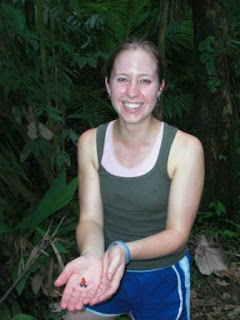One important component of the OTS USAP (Undergraduate Semester Abroad Program) is independent projects (IPs). Essentially, students have a full week to plan, carry out, present, and write up an entire research project. There are two IPs throughout the semester, and the first one took place during our second week at La Selva. The reasons I'm making an entire post about my IP are a) it had a pretty interesting topic and b) it was somewhat hilariously filled with complications and problems. Here goes.

Project Development
My partner for the first IP was a student from University of Washington (Seattle) named Andrés, and after lots of paper-reading and researching, we decided that we wanted to do a project on poison-dart frogs (Dendrobates pumilio). This particular species is very common at La Selva. Adults are small - about 2.5 cm in length or so - and are aposematically colored bright red and blue. Their skin is only slightly toxic (i.e., not dangerous to humans), but this toxicity renders them generally unpalatable to predators. It has been shown that the frogs sequester their skin toxins from their prey, but no research has been performed to examine how this affects their foraging decisions. One important class of skin toxins are the pumiliotoxins, which out of hundreds of ant genera examined, have only been found in the ant genera Brachymyrmex and Paratrechina. Thus, the question we asked was this:

The PlanOur plan was simple. Trap a frog and put four pumiliotoxin-containing ants and four non pumiliotoxin-containing ants in a container with it, and return later to see which kind of ant the frog prefers to eat. We had five days to perform the experiment and one to put together a presentation... and thus the saga began.

^Me with poison-dart frog.
Day 1Morning #1 of our IP, and I was already panicking. By then, we should have ideally located both genera of ants somewhere at La Selva, but we had found neither. Andrés and I had spent hours in front of microscopes with giant ant books trying to identify ants we'd collected around the station and in the forest, but that proved absolutely impossible. We trapped ants around the dining hall, in the lab, in the field, and in the forest, and although we obtained lots of ant samples, we couldn't definitively identify a single ant. We also tried and failed to fashion some kind of enclosure for the ants and frogs, but either the ants or frogs (or both) managed to escape from every kind of enclosure we tried. At the end of the day, essentially nothing had been accomplished besides a lot of learning what didn't work.
^Ant identification = impossible.
Day 2
I was now panicking completely, despite Andrés's efforts to convince me that it would eventually work out. On day 2, though, we got a good break. Ronald Vargas, the station's resident ant expert, returned in the morning and came to our lab to help us identify our ants. At this point we got a small miracle: our lab was literally infested with Paratrechina ants, and another ant species we trapped near the dining hall (genus Pheidole) would serve as a suitable control ant. Our first method for trapping the ants in the lab was an aspirator, but much to Andrés's dismay, the ants were sucked right through the mesh and into his mouth when he tried to use it. Soon, though, we realized that we could somewhat effectively sweep the ants from the counter if we first baited them with honey. We decided to just use plastic bags tied closed with a knot for our enclosures, and after an intense frog-catching session, we set up 30 frogs in bags with 8 ants each during the afternoon. We returned after dinner to count ants, but none had been eaten.
 ^The Paratrechina ants infesting our lab.
^The Paratrechina ants infesting our lab.
Day 3
First thing in morning, we counted the ants again. Still, not a single ant was missing, although some had drowned in the moisture in the bags. We still hadn't found Brachymyrmex ants, so we set traps throughout the forest on epiphytes and in leaf litter, where these ants are (in theory) common. We then attempted to address the problem of our frogs refusing to eat. The first step was to eliminate the plastic bags. We managed to track down a graduate student at the station who had an excess of plastic containers with lids, so we borrowed about 60 of them. The containers had small holes poked in the lids, so we put a bunch of ants in a container with a lid and put the container in a plastic bag. No ants appeared inside the bag but outside the container, and thus we concluded that the ants couldn't escape through the holes. Our new containers required us to not only move our 30 frogs, but also to replace all 240 ants in the containers, especially since many ants were dead anyway. We had plenty of Paratrechina ants infesting the lab, but our control Pheidole ants had mysteriously disappeared from the place where we had originally trapped them. Thus, Andrés and I went on a two-hour quest in the woods to find new control ants, which build their nests on Arecaceae and Cyclanthaceae leaves. Finally, we were able to set up our frogs in their new containers. Hoping a change from the indoor classroom environment would also help, we put some of the containers in the woods and some in an outdoor shadehouse. A few hours later, I went to count ants in the containers in the woods. I picked up the first container and counted 10 ants - the eight ants we had placed in the container plus two different, smaller ones. Baffled, I continued to count ants in the other containers, obtaining similar results. Slowly it dawned on me that although our ants couldn't get out of the containers, smaller ants living in the forest could get into them. Why they would do this is beyond me, but the end result was that we had to replace ants in about 15 containers yet again. Later, after dinner, we went to count ants in the shadehouse containers. Not only had no ants still been eaten, but a couple of frogs had died because we were unaware that the shadehouses can get extremely hot during the day. Discouraged and frustrated, we let the remaining shadehouse frogs free and finally went to bed around 10 PM.

^A few of our containers, complete with frog, ants, and wet cotton ball for moisture. We separated them with cardboard because the frogs are very visually sensitive.
Day 4
On the fourth day, we finally got another good break. Ronald found me after breakfast, excitedly reporting that he had finally found Brachymyrmex ants crawling around on an Inga plant outside his office. He carefully showed me which ants to look for on the plant, as there were many ants besides Brachymyrmex present. The ants in question were impossibly tiny - less than a millimeter long, black, and not terribly common on the plant. We tried to trap them, but the bigger ants on the plant quickly monopolized the honey in the trap. The only way to catch them, then, was with an aspirator. Now that we were catching miniscule ants, I added about six layers of mesh to the aspirator and went at it. For about three hours I stood in front of the Inga plant, watching carefully for Brachymyrmex to come crawling by and then quickly sucking them up. Each time I trapped four, I put them in a plastic container, to which Andrés added four control Tapinoma ants that we trapped behind the dining hall. After sucking up around 120 ants and catching 30 more frogs, we finally had 30 more frog-ant setups. Problematically, though, still not a single ant had been eaten, and thus we had zero data. At this point we were fully expecting to write a grant proposal instead of a paper, which was our professor's solution to the zero-data problem.

^The end of the aspirator (about 1 cm diameter) and a Brachymyrmex, which is barely visible as a little black dot on the leaf.
Day 5
On the morning of the fifth day, we went to the classroom to count the tiny ants in our containers. We had taped shut each tiny little hole in the lids, so there was no way the ants could escape (or enter!) this time. We could hardly believe it when we started counting ants and - low and behold - we counted less than eight in most containers! We set free the frogs that had eaten ants, and came back later to do more counting after more frogs had eaten. Finally, we had data - hallelujah!
The Ending
In the end, our data showed pretty clearly that the frogs didn't prefer either type of ant (Brachymyrmex or control Tapinoma) over the other. This was still an interesting result, and much of our presentation and papers focused on finding explanations for it. Our advising professor, Erika, was proud of us for sticking with what she said was the most interesting poison-dart frog project she had seen in 15-ish years. The second IP is scheduled for our last site, Palo Verde - hopefully that one will go at least a little more smoothly :)



 ^Cuerici: Hanging out after deciding to walk the 3-ish kilometers back to the station instead of riding in the car... this after the all-day hike. Notice we're right at the level of the clouds.
^Cuerici: Hanging out after deciding to walk the 3-ish kilometers back to the station instead of riding in the car... this after the all-day hike. Notice we're right at the level of the clouds. 
 ^La Selva: Slug-eating snake we found on a night hike :)
^La Selva: Slug-eating snake we found on a night hike :) ^La Selva: During a free day, a few of us decided to go out and explore the forest. While following a trail that led off one of the main trails, we first found a strange house-like building that was literally covered in bats. Afterwards, we continued following the small trail down to the river, where we found this awesome cable-car contraption and propelled ourselves across the river to continue our hike. I probably shouldn't mention that this was during a thunderstorm...
^La Selva: During a free day, a few of us decided to go out and explore the forest. While following a trail that led off one of the main trails, we first found a strange house-like building that was literally covered in bats. Afterwards, we continued following the small trail down to the river, where we found this awesome cable-car contraption and propelled ourselves across the river to continue our hike. I probably shouldn't mention that this was during a thunderstorm... ^La Selva
^La Selva ^La Selva: butterfly... note Becca's awesome photography skills.
^La Selva: butterfly... note Becca's awesome photography skills. ^La Selva: White tent bats. They make tents out of Heliconiaceae or Marantaceae leaves and cuddle up under them. Adorable.
^La Selva: White tent bats. They make tents out of Heliconiaceae or Marantaceae leaves and cuddle up under them. Adorable.





 ^The Paratrechina ants infesting our lab.
^The Paratrechina ants infesting our lab.















 ^The bridge we cross to get to and from class and the forest. Sweet, right?
^The bridge we cross to get to and from class and the forest. Sweet, right? 
















